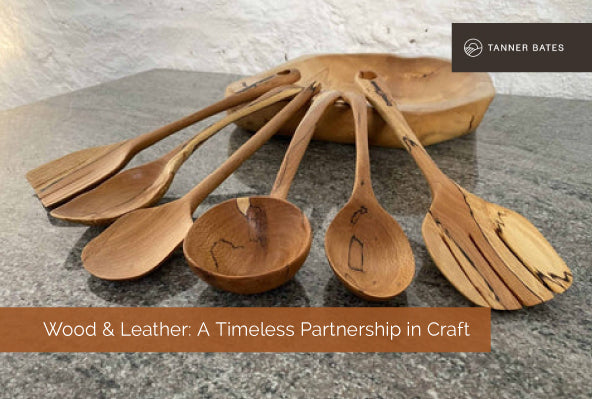June 12, 2025
How to Clean a Leather Wallet: The Expert Guide
Regular maintenance, including proper cleaning and conditioning twice yearly, significantly extends your wallet's lifespan while potentially helping to disguise those annoying stains and work them further into the leather to build an excellent patina. Occasionally marks can totally disappear or scratches polished away, however especially with the sort of full grain vegetable tanned leather we use here at Tanner Bates, these marks are all part of the leather's story and help to build an unrivalled patina.
Gather your cleaning arsenal.
You'll need:
A soft, clean, lint free cloth
Tanner Bates Liquid Wax
Horsehair polishing brush or soft bristled clean shoe brush
Our Liquid Wax is designed as a mild cleaner and dressing. Dedicated leather cleaners or saddle soap work brilliantly too - just follow their specific instructions. Wherever possible, we recommend gentle and natural products.
Some leathers can be wiped with a damp cloth, however it isn't something we'd recommend for one of our products. If you opt for wiping the product with a damp cloth, err very much on the side of dryer (virtually dry) rather than wetter, water and leather are not good friends! Exposure to even the smallest amount of water can irreversibly stain our leathers. Then always ensure the leather is left to fully air dry (away from heat sources), before applying a conditioner or polish.
Please note that this is not designed or recommended for use with suede or nubuck, which require specialist treatments.
Never use harsh chemicals like ammonia or bleach. These aren't just bad for leather - they're absolute destroyers of its natural beauty and structure.
The Tanner Bates touch – why our leather care kit is different
When it comes to conditioning, not all products are created equal. At Tanner Bates, we’re leather purists. We hand-make our wallets using traditional techniques, and we believe in maintaining them the same way - without shortcuts, silicones or synthetic chemicals. That’s why we created our own
Tanner Bates Leather Care Kit, carefully designed for the unique needs of full-grain
and vegetable tanned leather.
The gentle touch - circular motions only
Apply some Tanner Bates Liquid Wax to the cloth, or if you are opting for an alternative, follow the manufacturer's instructions. Please note that this is not designed or recommended for use with suede or nubuck, which require specialist treatments.
Starting from one edge, gently rub the leather in uniform circular motions. Light pressure is key here - you're coaxing the dirt away, not scrubbing at it. Begin with exterior surfaces, then move to interior sections and pockets.
Leather is naturally porous - excessive pressure or moisture can cause damage that's difficult to reverse.
If you are using our Liquid Wax, once dry, polish with the brush. If you have opted for an alternative, follow the manufacturer's instructions.
Drying and conditioning your wallet - the crucial steps
Drying and conditioning your wallet after cleaning? It's not just important - it's ESSENTIAL. This step makes the difference between leather that withers and dies and leather that lives on for generations. Let's get it right.

Gilboy’s Leather Balsam – A Deeper Nourish for Timeworn Leather
For wallets that are showing signs of serious wear – dryness, stiffness, or a faded surface that’s lost its warmth –
Gilboy’s Leather Balsam is a deeper treatment worth reaching for. Made in the UK
(just a stones throw from our workshop) and trusted by leatherworkers, it’s a rich blend of natural ingredients, including beeswax, essential oils, and lanolin. Unlike generic conditioners that sit on the surface, this balsam penetrates deep into the fibres, replenishing lost oils and restoring suppleness without leaving a greasy finish. It’s ideal for older leather products or those exposed to years of wear and tear – and yes, it smells absolutely incredible.
At Tanner Bates, we use Gilboy’s Leather Balsam when a wallet needs more than a quick refresh – when it needs to be revived. Apply sparingly using a soft cloth, working it into the leather in gentle circles, and allow it to rest overnight. In the morning, you’ll notice an immediate difference: improved colour, restored flexibility, and that soft, velvety touch that only well-fed leather can offer. It’s a rescue balm for leather that’s seen life – and wants to keep going. Brush off any excess that hasn't been absorbed.
The rest period - patience pays off.
After conditioning, patience becomes your best friend. Allow your wallet to rest and absorb the conditioner fully - typically overnight or about 24 hours. This waiting period ensures the conditioner penetrates deep into the leather fibres, restoring flexibility from within. Brush off any excess that hasn't been absorbed. It is always better to apply a small amount initially and then apply a second dose rather than applying too much in the first instance - If the leather becomes saturated, it cannot absorb any more leather conditioner and might become greasy to touch.
How often should you clean and condition your leather wallet?
Let's be honest - most of us neglect our
wallets until they're looking sad and tired. But consistency is key. Typically, conditioning should occur every 3-6 months to replenish natural oils and prevent drying or cracking. If your wallet endures heavy use or harsh climates, you might need to condition it 3-4 times annually.
If your wallet gets wet, allow to dry naturally and then apply a dose of quality natural leather conditioner to help rehydrate and replace any natural oils and fats that have been lost. It is the process of becoming wet and drying that dehydrates the leather most.
For regular maintenance, a monthly wipe-down with a soft, dry cloth removes dust, sweat and skin oils. This simple habit prevents build-up that damages leather over time. Then, twice yearly, give your wallet a proper deep clean with a leather-specific cleaner before conditioning.
Climate matters, too. Living somewhere dry? Your wallet needs more frequent conditioning. Humid environment? More regular cleaning prevents mould growth. At Tanner Bates, we recommend adjusting your care routine to your specific conditions.
Frequently asked questions about how to clean a leather wallet:
For regular maintenance, wipe your wallet monthly with a soft, dry cloth. Deep clean it every six months using a leather-specific cleaner. Condition your wallet every 3-6 months or more frequently if exposed to harsh conditions.
Can I use water to clean my leather wallet?
Avoid submerging your leather wallet in water or using regular soap. Water and leather are not good friends. Even a small amount of moisture can irreversibly stain leather. We recommend a quality natural gentle specialised leather cleaner. Always test on a small, inconspicuous area first.
How can I remove stubborn stains from my leather wallet?
Not all stains can be removed. The use of a quality natural leather conditioner can potentially help to disguise those annoying stains and work them further into the leather to help build an excellent patina.
Occasionally marks can totally disappear or scratches polished away and the first mark is always the most painful. However especially with the sort of full grain vegetable tanned leather we use here at Tanner Bates, these marks are all part of the leather's story and help to build an unrivalled patina. For tough stains, use a cleaner specifically designed for leather. Apply it gently with a soft cloth, working in circular motions. For ink stains, you may need a specialised ink remover suitable for leather.
Always avoid the use of chemicals on naturally tanned leather.
How do different types of leather affect how I clean my wallet?
The type of leather used in your wallet makes a significant difference in how you clean and care for it. Full-grain and vegetable tanned leathers (like those used by Tanner Bates) are more durable and develop a beautiful natural patina over time, but they require gentle, regular conditioning to stay supple. Genuine leather wallets - despite the name - are often lower quality and may not age as gracefully. Chrome tanned leather does not patina either, it just becomes dirty. This type of leather, along with bonded leather or faux leather (synthetic alternatives) have completely different care/cleaning needs. Synthetic leathers don’t benefit from conditioning, as they lack the natural fibres real leather possesses. Always check what you’re working with before applying any products.
What’s the best way to treat minor stains on the surface of leather?
Minor stains on the surface of leather - like fingerprints,
ink, light dirt, or watermarks -
might be treatable with a soft cloth dampened with
Tanner Bates Liquid Wax. Gently
apply in circular motions, then once dry brush with a horsehair polishing brush. Avoid using household items like white vinegar, which can discolour or dry out natural leather if used undiluted. For Tanner Bates wallets, we always recommend using our Leather Care Kit to lift
or disguise minor blemishes while protecting the leather’s natural oils.
Why does leather change as it ages?
As vegetable tanned leather ages, it goes through a process known as patination. With exposure to oils from your hands, sunlight, friction, and even air, natural leather develops deeper tones and a unique sheen known as a natural patina. This ageing process enhances the beauty and character of the wallet. While synthetic or faux leather may degrade or peel with time, high-quality natural leather only improves if properly cared for with a regular cleaning and conditioning process.
Can I use white vinegar to clean my wallet?
White vinegar is often mentioned in DIY cleaning guides, but we don’t recommend it for full-grain or veg-tanned leather. While diluted vinegar can sometimes help lift tough stains, it’s also acidic and can strip away essential oils - leaving the leather dry and more prone to cracking. For stubborn spots, stick with products specifically made for leather or use our Leather Care Kit, which safely conditions while cleaning.
What’s the best way to prevent water stains on my leather wallet?
Prevention is better than the cure, so try to keep your wallet from getting wet! To
help prevent
water stains, always condition your wallet regularly
with a quality natural leather conditioner. A well-conditioned wallet forms a subtle barrier that
can repel moisture more effectively. If your wallet does get wet, blot gently with a dry cloth and let it air dry naturally - never rub or apply heat. For added protection, consider using a leather protector after conditioning to guard against future spills and weather.
How do I know what type of stain I’m dealing with?
Understanding the type of stain helps you choose the right cleaning method. A lot of stains and marks are permanent, especially with full grain vegetable tanned leather. The first is always the most painful, however it is all part of the story of your wallet and development of the patina, unique to you. Oil-based marks (from hands or food) usually darken the leather and might be gently lifted with a leather cleaner. Ink stains can require more targeted treatments and will likely not come out entirely. Water stains often appear lighter and can be minimised/disguised with prompt blotting and reconditioning. When in doubt, test on a small hidden area or consult a leather specialist - especially for high-quality pieces like those from Tanner Bates.
Leave a comment
Comments will be approved before showing up.







